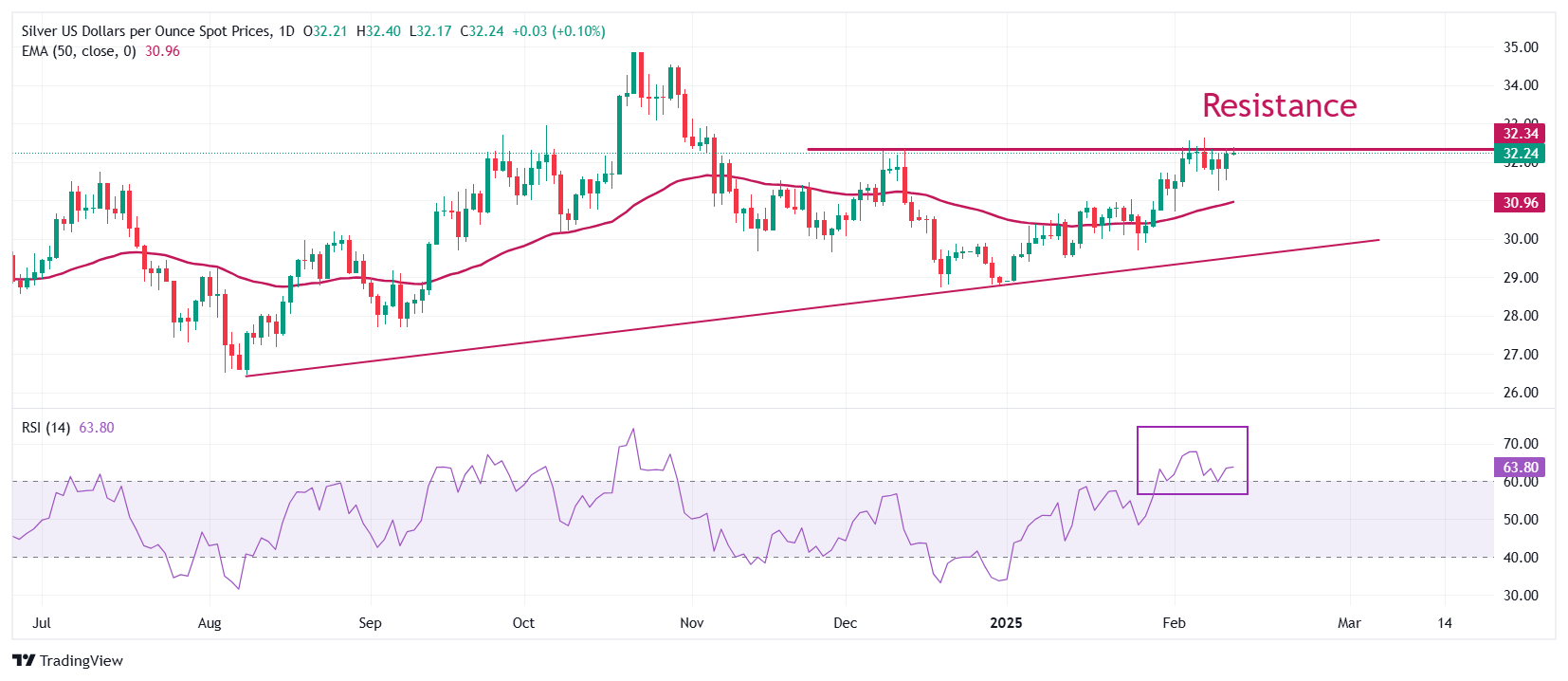Silver Price Forecast: XAG/USD clings to gains above $32 as traders brace for Trump’s reciprocal tariffs
- Silver price grips gains near $32.30 amid weakness in the US Dollar and uncertainty over Trump’s reciprocal tariffs.
- The US Dollar declines as optimism over Russia-Ukraine peace talks has improved market sentiment.
- Hot US CPI data for January has boosted expectations for the Fed’s “higher for longer” interest rates.
Silver price (XAG/USD) holds onto gains near Wednesday’s high around $32.30 in Thursday’s European session. The white metal remains firm amid uncertainty that United States (US) President Donald Trump will announce reciprocal tariffs on Thursday.
The White House said on Wednesday that US President Donald Trump could announce his reciprocal tariff plan before he meets with Indian Prime Minister Narendra Modi on Thursday.
Such a scenario would deepen fears of a global trade war, which will boost the safe-haven appeal of precious metals, such as Silver.
In the election campaign, Trump said that he would implement a policy of “an eye for an eye, a tariff for a tariff, same exact amount.”
Meanwhile, the market sentiment is risk-on as leaders of Russia and Ukraine have agreed to peace talks after a three-year-long war. The Silver price had a strong rally when Russia and Ukraine entered a war.
Apart from the uncertainty over Trump’s tariffs, the Silver price clings to gains due to weakness in the US Dollar (USD). Risk-on market mood due to Russia-Ukraine peace talks has weighed heavily on the US Dollar, with the US Dollar Index (DXY) declining to near 107.50.
The US Dollar weakens even though the hot US Consumer Price Index (CPI) report for January has boosted expectations that the Federal Reserve (Fed) will keep interest rates in the current range of 4.25%-4.50% for longer. Technically, higher interest rates for longer bodes poorly for the Silver price.
Silver technical analysis
Silver price continues to face pressure near the immediate resistance of $32.50, which is plotted from the December 9 high. The outlook of the white metal remains bullish as it holds above the 50-day Exponential Moving Average (EMA), which trades around $30.95.
The 14-day Relative Strength Index (RSI) falls back inside the 40.00-60.00 range, suggesting that the momentum is not bullish for now. However, the upside bias is intact.
Looking down, the upward-sloping trendline from the August 8 low of $26.45 will be the key support for the Silver price around $29.50. While, the October 31 high of $33.90 will be the key barrier.
Silver daily chart
Silver FAQs
Silver is a precious metal highly traded among investors. It has been historically used as a store of value and a medium of exchange. Although less popular than Gold, traders may turn to Silver to diversify their investment portfolio, for its intrinsic value or as a potential hedge during high-inflation periods. Investors can buy physical Silver, in coins or in bars, or trade it through vehicles such as Exchange Traded Funds, which track its price on international markets.
Silver prices can move due to a wide range of factors. Geopolitical instability or fears of a deep recession can make Silver price escalate due to its safe-haven status, although to a lesser extent than Gold's. As a yieldless asset, Silver tends to rise with lower interest rates. Its moves also depend on how the US Dollar (USD) behaves as the asset is priced in dollars (XAG/USD). A strong Dollar tends to keep the price of Silver at bay, whereas a weaker Dollar is likely to propel prices up. Other factors such as investment demand, mining supply – Silver is much more abundant than Gold – and recycling rates can also affect prices.
Silver is widely used in industry, particularly in sectors such as electronics or solar energy, as it has one of the highest electric conductivity of all metals – more than Copper and Gold. A surge in demand can increase prices, while a decline tends to lower them. Dynamics in the US, Chinese and Indian economies can also contribute to price swings: for the US and particularly China, their big industrial sectors use Silver in various processes; in India, consumers’ demand for the precious metal for jewellery also plays a key role in setting prices.
Silver prices tend to follow Gold's moves. When Gold prices rise, Silver typically follows suit, as their status as safe-haven assets is similar. The Gold/Silver ratio, which shows the number of ounces of Silver needed to equal the value of one ounce of Gold, may help to determine the relative valuation between both metals. Some investors may consider a high ratio as an indicator that Silver is undervalued, or Gold is overvalued. On the contrary, a low ratio might suggest that Gold is undervalued relative to Silver.




